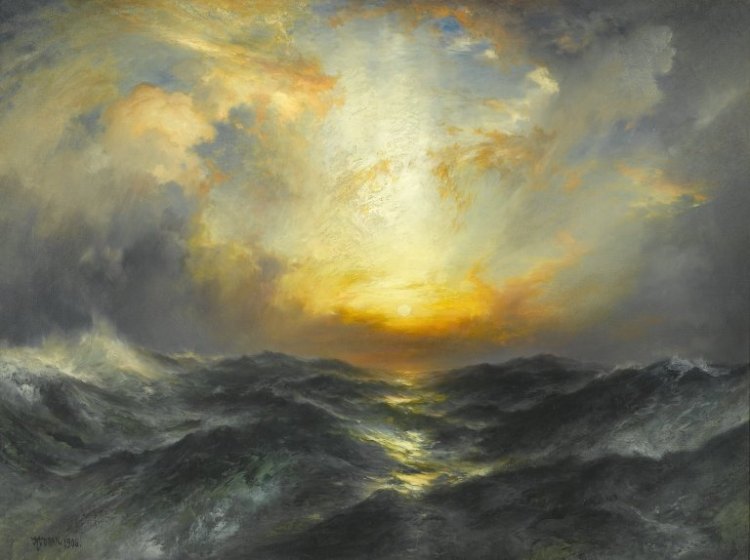
Painting by Thomas Moran – Sunset at Sea (ca. 1906)
Adieu, adieu! my native shore
Fades o’er the waters blue;
The night-winds sigh, the breakers roar,
And shrieks the wild sea-mew.
Yon sun that sets upon the sea
We follow in his flight;
Farewell awhile to him and thee,
My Native Land – Good Night!
– Lord Byron: Childe Harold’s Pilgrimage – Canto One. XIII
As I continue to research the American Romantic Era’s painters most closely associated with the Hudson River School and the Luminism style for one of my upcoming projects, I am also diving back into the work of the English Romantic poets, specifically Lord Byron and John Keats. My primary concerns are the exploration of the the civilizational move from the Edenic/Arcadian, to the decadence of Empire, through the inevitable fall of Empire, on into the renewal of an eschatological and cosmopolitan Eden/Arcadia. I’ll probably post some more of my sketches for Inter Æons that will filter in some way into the completed work.
One of my favorite aspects of artistic research is that it is never as detached or disinterested as disciplines like scientific research necessarily must be. So, as I am reading through Byron’s Childe Harold’s Pilgrimage I am reading through the words of a master who knew all too well the sort of journey that the manic-depressive writer must traverse in order to create. While the notion of a tortured artist is a well-worn cliche, it can only be this way because of the truth that lies beneath it. Harold – a character that is said to resemble Byron himself, is a mercurial wanderer beset by the kinds of contradictions that most anyone who has battled bipolar disorder knows in the most visceral terms. While my own contradictions and battles might not be exaggerated to such a degree that I am some sort of Byronic Hero (or anti-hero), Harold’s revelries with wine, women, and song as he journeys far from home are something that I can identify with – sometimes his lines leave me laughing in stitches or cringing over memories of my much wilder past.
All of this brought back one of the most important works in the field of Bipolar Disorder research – Touched with Fire by world renowned psychiatric researchers, Dr. Kay Jamison. In Touched with Fire, explores the correlation between art and mental illness (featuring several bipolar artists, Byron included). Jamison herself battles bipolar disorder, and writes with intellectual flare that is uncommon for this sort of research literature. In it she notes:
From virtually all perspectives – early Greek philosopher to twentieth-century specialist – there is agreement that artistic creativity and inspiration involve, indeed require, a dipping into pre-rational or irrational sources while maintaining ongoing contact with reality and “life at the surface” The degree to which individuals can, or desire to , “summon up the depths” is among the more fascinating individual differences. Many highly creative and accomplished writers, composers, and artists functioning essentially within the rational world, without losing access to their psychic “underground”… The integration of these deeper, truly irrational sources with more logical processes can be a torturous task, but, if successful, the resulting work often bears a unique stamp, a “touch of fire,” for what it has been through.
So, like Byron, the artist’s task is to be able to oscillate from life at the surface and the subterranean depths. Perhaps there’s a little madness on this odyssey, but I would argue that certain kinds of madness are necessary for good art. Whether you’re temperament is even-keeled or manic depressive, if you’re inclined to create don’t fear to tread paths that might seem a little crazy to the outside observer.

I love this painting! I’ve seen a few like it but never knew the style was called luminism.
Interesting blog, too. I’ve just followed it. Look forward to reading more of your poems.
LikeLiked by 1 person
Thanks Chris! I just saw your site as well. I look forward to digging in and taking a look at your work!
LikeLike
BTW, Chris if you like the luminists works it is also well worth checking out contemporary neoluminists like April Gornik and Stephen DaLuz. I’ll post some links to their work in the near future.
LikeLiked by 1 person
Thank you! I’m very new to writing poetry, so please feel free to give me pointers. 🙂
LikeLiked by 1 person
Excellent. I look forward to it.
LikeLike
I showed the painting to my daughters (8 and 3) and they said, “woh, that looks real”. 🙂
LikeLiked by 1 person
Thanks so much for checking out my poems, Jedidiah! And for your encouragement. I probably will take you up on your offer and email you sometime soon.
LikeLike
Very cool! It’s always interesting to hear what kids have to say about art. I did browse some of your poems earlier this afternoon and enjoyed reading them. I’ll comment more on them in the coming days, but they are quite good and I think you have a lot of potential to write some powerful work as you continue to hone your skills. If you ever want to converse more about your work I’d be happy to chat.
LikeLike